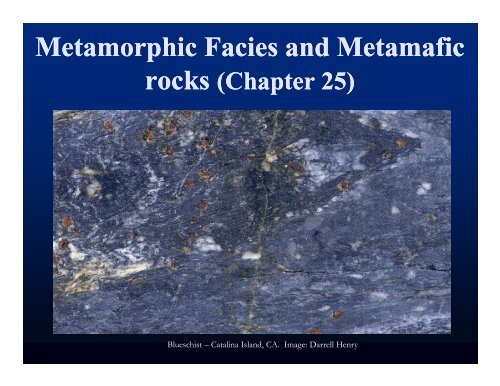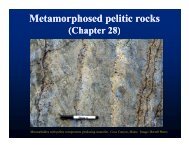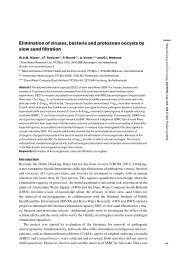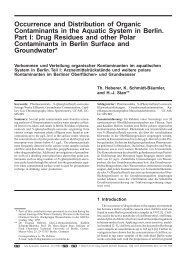Metamorphic Facies and Metamafic
Metamorphic Facies and Metamafic
Metamorphic Facies and Metamafic
Create successful ePaper yourself
Turn your PDF publications into a flip-book with our unique Google optimized e-Paper software.
<strong>Metamorphic</strong> <strong>Facies</strong> <strong>and</strong> <strong>Metamafic</strong><br />
rocks k (Chapter 25)<br />
Blueschist – Catalina Isl<strong>and</strong>, CA. Image: Darrell Henry
<strong>Metamorphic</strong> <strong>Facies</strong> Concept<br />
Pentii Eskola (1914) Orijärvi region of southern Finl<strong>and</strong><br />
Rocks with K-feldspar + cordierite at Oslo<br />
contained the compositionally p yequivalent q pair p<br />
biotite + muscovite at Orijärvi<br />
• Eskola: difference must reflect differing<br />
physical conditions between the regions<br />
• Concluded that Finnish rocks equilibrated<br />
at llower temperatures <strong>and</strong> dhi higher h pressures<br />
than Norwegian ones<br />
Eskola (1915) developed the concept of metamorphic facies:<br />
"In any rock or metamorphic formation which has arrived at a chemical<br />
equilibrium q through g metamorphism p at constant temperature p <strong>and</strong> ppressure<br />
conditions, the mineral composition is controlled only by the chemical<br />
composition. We are led to a general conception which the writer proposes to call<br />
metamorphic facies."
<strong>Metamorphic</strong> <strong>Facies</strong> Concept<br />
Dual basis for the facies concept<br />
Descriptive: relationship between rock composition <strong>and</strong> its<br />
mineralogy<br />
• A metamorphic facies is set of repeatedly associated<br />
metamorphic mineral assemblages<br />
• If we find specified assemblage or group of compatible<br />
assemblages covering range of compositions in the field, then a<br />
certain ti facies f i may bbe assigned i dtto th the area<br />
Interpretive: range of T <strong>and</strong> P conditions represented by each facies<br />
• Eskola was aware of T-P implications of concept <strong>and</strong> correctly<br />
deduced the relative T <strong>and</strong> P represented by different facies<br />
W i l i l T dP li i<br />
• We can now assign relatively accurate T <strong>and</strong> Pe limits to<br />
individual facies
<strong>Metamorphic</strong> <strong>Facies</strong> Concept<br />
Defined on the basis of mineral assemblages that develop<br />
in mafic rocks<br />
Image: Winter (2001)<br />
Eskola (1920) proposed 5<br />
original facies:<br />
• Greenschist<br />
• Amphibolite<br />
• Hornfels<br />
• Sanidinite<br />
• Eclogite<br />
Eskola (1939) added<br />
• Granulite<br />
• Epidote-amphibolite<br />
• Blueschist<br />
Later additions<br />
• Zeolite<br />
• Prehnite-pumpellyite<br />
• Albite-epidote hornfels<br />
• Hornblende hornfels
<strong>Metamorphic</strong> <strong>Facies</strong> Concept<br />
Defined on the basis of mineral assemblages that develop<br />
in mafic rocks<br />
IUGS IUGS-SCMR SCMR version of<br />
facies diagram<br />
Image: IUCS-SCMR (2007)
<strong>Metamorphic</strong> <strong>Facies</strong> Concept<br />
Defined on the basis of mineral assemblages that develop<br />
in mafic rocks<br />
Table 25-1. Definitive Mineral Assemblages of <strong>Metamorphic</strong> <strong>Facies</strong><br />
<strong>Facies</strong> Definitive Mineral Assemblage in Mafic Rocks<br />
Zeolite zeolites: especially laumontite, wairakite, analcime<br />
Prehnite-Pumpellyite prehnite + pumpellyite (+ chlorite + albite)<br />
Greenschist chlorite + albite + epidote (or zoisite) + quartz ± actinolite<br />
Amphibolite hornblende + plagioclase (oligoclase-<strong>and</strong>esine) ± garnet<br />
Granulite orthopyroxene (+ clinopyrixene + plagioclase ± garnet ±<br />
hornblende)<br />
Blueschist glaucophane + lawsonite or epidote (+albite ± chlorite)<br />
Eclogite pyrope garnet + omphacitic pyroxene (± kyanite)<br />
Contact <strong>Facies</strong><br />
After Spear (1993)<br />
Mineral assemblages in mafic rocks of the facies of contact metamorphism<br />
do not differ substantially from that of the corresponding<br />
regional facies at higher pressure.
<strong>Metamorphic</strong> <strong>Facies</strong> Concept<br />
<strong>Metamorphic</strong> field gradient - array of peak metamorphic (max T)<br />
experienced in a metamorphic terrain<br />
Typical<br />
Barrovian-type<br />
metamorphic<br />
field gradient<br />
<strong>and</strong> a series of<br />
metamorphic P-<br />
T-t paths for<br />
rocks found<br />
along that<br />
gradient in<br />
fi field. ld<br />
Image: Winter (2001)
<strong>Metamorphic</strong> <strong>Facies</strong> Concept<br />
<strong>Metamorphic</strong> field gradient<br />
Image: Winter (2001)<br />
<strong>Metamorphic</strong> field<br />
gradients<br />
(estimated PP-T T<br />
conditions along<br />
surface traverses<br />
directly y up p<br />
metamorphic<br />
grade) for several<br />
metamorphic<br />
areas.
<strong>Metamorphic</strong> <strong>Facies</strong> Concept<br />
<strong>Metamorphic</strong> series<br />
Image: Winter (2001)<br />
Miyashiro (1961) initially<br />
proposed five facies series,<br />
most of them named for a<br />
specific representative "type<br />
locality" The series were:<br />
1. Contact <strong>Facies</strong> Series (very<br />
low-P)<br />
22. Buchan or Abukuma <strong>Facies</strong><br />
Series (low-P regional)<br />
3. Barrovian <strong>Facies</strong> Series<br />
(medium (medium-P P regional)<br />
4. Sanbagawa <strong>Facies</strong> Series<br />
(high-P, moderate-T)<br />
5. Franciscan <strong>Facies</strong> Series<br />
(high-P, low T)
Metamorphism of Mafic Rocks<br />
Mineral changes <strong>and</strong> associations that develop with increasing<br />
metamorphic grade<br />
• Hydrous minerals are not common in high-<br />
T igneous mafic protolith, so hydration is a<br />
prerequisite for development of<br />
metamorphic mineral assemblages that<br />
characterize most facies<br />
• Unless water is available, mafic igneous<br />
rocks will remain largely unaffected in<br />
metamorphic terranes, even as associated<br />
sediments are completely re re-equilibrated<br />
equilibrated<br />
• Coarse-grained intrusives are least<br />
permeable, <strong>and</strong> thus most likely to resist<br />
metamorphic changes, while tuffs <strong>and</strong><br />
graywackes are most susceptible
Metamorphism of Mafic Rocks<br />
Mineral changes <strong>and</strong> associations that develop with increasing<br />
metamorphic grade<br />
Plagioclase<br />
• As T is lowered, lo ered the more Ca-rich Ca rich plagioclases become<br />
progressively unstable<br />
• There eeis sa general gee correlation co e o between beweeT <strong>and</strong> dmaximum u An-<br />
content of stable plagioclase<br />
• At low metamorphic grades only albite (An0-3) is stable<br />
• IIn upper-greenschist hi ffacies i oligoclase li l bbecomes stable. bl<br />
• Andesine(~An40) <strong>and</strong> more calcic plagioclases are stable in upper<br />
amphibolite <strong>and</strong> granulite facies<br />
• Excess Ca <strong>and</strong> Al released may released from calcite, calcite an epidote mineral, mineral<br />
titanite, or amphibole, etc., depending on P-T-X<br />
Clinopyroxene breaks down to a number of mafic minerals,<br />
depending on grade. These include chlorite, actinolite, hornblende, epidote,<br />
a metamorphic pyroxene, etc., <strong>and</strong> the one(s) that form are commonly<br />
diagnostic of the grade <strong>and</strong> facies
Metamorphism of Mafic Rocks<br />
Stilbite on basalt (Poona, India). Image: Darrell<br />
Henry (2007)<br />
Mafic Assemblages at Low Grades<br />
Zeolite <strong>and</strong> prehnite-pumpellyite facies<br />
• DDo not talways l ddevelop l - ttypically i ll<br />
require unstable protolith<br />
• Boles <strong>and</strong> Coombs (1975)<br />
showed that metamorphism of<br />
their tuffs in NZ was<br />
accompanied by substantial<br />
chemical changes due to<br />
circulating fluids fluids, <strong>and</strong> that fluids<br />
played important role in<br />
metamorphic minerals that were<br />
stable bl ii.e. strong component of f<br />
hydrothermal metamorphism.
Metamorphism of Mafic Rocks<br />
Mafic Assemblages of the Medium P/T Series: Greenschist,<br />
Amphibolite, <strong>and</strong> Granulite <strong>Facies</strong> (most common)<br />
Metamorphism p of mafic rocks is<br />
first evident in greenschist facies<br />
(correlates with chlorite <strong>and</strong> biotite<br />
zones of associated pelitic rocks)<br />
• Typical minerals include<br />
chlorite, hl i albite, lbi actinolite, i li<br />
epidote, quartz, <strong>and</strong> possibly<br />
calcite, biotite, or stilpnomelane<br />
ACF diagram g - The most characteristic mineral<br />
• Chlorite, actinolite, <strong>and</strong> epidote<br />
impart p the ggreen<br />
color from<br />
assemblage of the greenschist facies is: chlorite<br />
+ albite + epidote + actinolite ± quartz<br />
which mafic rocks <strong>and</strong> facies get<br />
their name<br />
Image: Winter (2001)
Metamorphism of Mafic Rocks<br />
Mafic Assemblages of the Medium P/T Series: Greenschist,<br />
Amphibolite, <strong>and</strong> Granulite <strong>Facies</strong> (most common)<br />
Greenschist to<br />
amphibolite facies<br />
transition involves 2<br />
major j mineralogical g<br />
changes<br />
Image: Winter (2001)<br />
1. Transition from albite<br />
to oligoclase (in (increased re sed<br />
Ca-content of stable<br />
plagioclase with T)<br />
22. Transition from<br />
actinolite to<br />
hornblende (amphibole<br />
becomes able to accept<br />
increasing amounts of<br />
aluminum <strong>and</strong> alkalis at<br />
higher T)
Metamorphism of Mafic Rocks<br />
Mafic Assemblages of the Medium P/T Series: Greenschist,<br />
Amphibolite, <strong>and</strong> Granulite <strong>Facies</strong> (most common)<br />
Image: Winter (2001)<br />
ACF diagram<br />
• Typically 2-phase Hbl-Plag<br />
• Most amphibolites are<br />
predominantly black rocks<br />
with up to 30% white<br />
plagioclase l i l<br />
• Garnet occurs in more Al-<br />
Fe-rich <strong>and</strong> Ca-poor mafic<br />
rocks <strong>and</strong> clinopyroxene in<br />
Al-poor-Ca-rich p<br />
ones
Metamorphism of Mafic Rocks<br />
Mafic Assemblages of the Medium P/T Series: Greenschist,<br />
Amphibolite, <strong>and</strong> Granulite <strong>Facies</strong> (most common)<br />
The transition from amphibolite to granulite facies occurs in the range 650-700oC Conversion of felsic gneiss (left)<br />
to charnockite (right -type of the<br />
granulite - opx granitoid).<br />
Kabbaldurga quarry, India Image:<br />
Darrell Henry<br />
• In presence of aqueous fluid, associated pelitic<br />
<strong>and</strong> quartzo-feldspathic rocks (including<br />
granitoids) g ) begin g to melt in this range g at low to<br />
medium pressures , so that migmatites may form<br />
<strong>and</strong> melts may become mobilized<br />
• Not all pelites <strong>and</strong> quartzo-feldspathic rocks reach<br />
granulite facies as a result<br />
• Mafic rocks generally melt at somewhat higher T<br />
• If H 2O is removed by earlier melts remaining mafic rocks<br />
may become depleted in water<br />
• HHornblende rnbl nd ddecomposes mp <strong>and</strong> nd orthopyroxene rth p r n +<br />
clinopyroxene appear<br />
• This reaction occurs over a T interval of at least 50 o C
Metamorphism of Mafic Rocks<br />
Mafic Assemblages of the Medium P/T Series: Greenschist,<br />
Amphibolite, <strong>and</strong> Granulite <strong>Facies</strong> (most common)<br />
Winter (2001)<br />
The granulite g facies is<br />
characterized by the<br />
presence of a largely<br />
anhydrous mineral<br />
assemblage<br />
IIn metabasites b i di diagnostic i<br />
mineral assemblage is<br />
orthopyroxene +<br />
clinopyroxene +<br />
plagioclase + quartz<br />
• GGarnet t is i also l common, <strong>and</strong> d<br />
minor hornblende <strong>and</strong>/or<br />
biotite may be present
Metamorphism of Mafic Rocks<br />
The origin of granulite facies rocks is complex <strong>and</strong> controversial.<br />
There is general agreement, however, on two points<br />
1) Granulites represent unusually hot conditions<br />
• T > 700 o C, geothermometry has yielded some very high T, i.e. >1000 o C<br />
• Average geotherm T for granulite facies depths should be ~500oC, suggesting that granulites are products of crustal thickening <strong>and</strong> excess<br />
heating<br />
2) Granulites are dry<br />
• These rocks didn’t melt due to lack of available H 2O<br />
• Granulite facies terranes represent deeply buried <strong>and</strong><br />
dehydrated roots of continental crust<br />
• Touret: fluid inclusions in granulite facies rocks of S.<br />
Norway are CO2-rich, while those in amphibolite facies<br />
rocks k are more H H2O-rich O ih<br />
• H 2O can be removed by H 2O-undersaturated melts
Metamorphism of Mafic Rocks<br />
Mafic Assemblages of the Medium P/T Series: Greenschist,<br />
Amphibolite, <strong>and</strong> Granulite <strong>Facies</strong> (most common)<br />
Winter (2001)
Metamorphism of Mafic Rocks<br />
Mafic Assemblages of the High P/T Series: Blueschist <strong>and</strong><br />
Eclogite <strong>Facies</strong><br />
Mafic rocks (<strong>and</strong> not pelites) develop<br />
Winter (2001)<br />
conspicuous <strong>and</strong> definitive mineral<br />
assemblages under high P/T<br />
conditions<br />
• High P/T geothermal gradients<br />
characterize subduction zones<br />
• Mafic blueschists are recognizable<br />
by color - useful indicators of<br />
ancient subduction zones<br />
• Great density of eclogites suggests<br />
that subducted basaltic oceanic<br />
crust becomes more dense than<br />
surrounding mantle
Metamorphism of Mafic Rocks<br />
Blueschist <strong>Facies</strong> - characterized in metabasites by presence<br />
of sodic blue amphibole stable only at high P (e.g.<br />
glaucophane)<br />
• Association of glaucophane<br />
+ lawsonite is diagnostic.<br />
• Albite breaks down at high<br />
pressure by reaction to<br />
jadeitic j py pyroxene + qquartz:<br />
NaAlSi 3O 8 = NaAlSi 2O 6 + SiO 2<br />
Ab = Jd + Qtz<br />
• Assemblage jadeite +<br />
quartz indicates highpressure<br />
blueschist facies<br />
Winter (2001)
Metamorphism of Mafic Rocks<br />
Eclogite <strong>Facies</strong> - mafic assemblage omphacitic pyroxene +<br />
pyrope-grossular garnet (Christmas-tree rocks)<br />
Winter (2001)<br />
• Along higher geothermal<br />
gradients amphibolite<br />
facies, or even the granulite<br />
ffacies, i may llead d to eclogite l i<br />
facies<br />
• MMuch hof f blueschist, bl hi <strong>and</strong> dall ll<br />
of eclogite facies are<br />
marked by y high-pressure<br />
g p<br />
instability of plagioclase, a<br />
common phase in<br />
metabasites of any other<br />
grade
Metamorphism of Mafic Rocks<br />
<strong>Metamorphic</strong> field gradient (<strong>and</strong> PTt paths)<br />
(upper left) crustal thickening<br />
(clockwise ( (clockwise p path) )<br />
Image: Winter (2001)<br />
(left) shallow magmatism heat heat-flow flow<br />
(above) ( ) model for some types yp of<br />
granulite facies metamorphism<br />
(counter (counter-clockwise clockwise path)
Metamorphism of Mafic Rocks<br />
Winter (2001)<br />
Pressure-Temperature-Time Pressure Temperature Time (P (P-T-t) T t) Paths<br />
Temporal implication of<br />
progressive metamorphism:<br />
that rocks pass through series<br />
of mineral assemblages upon<br />
continuously yequilibrate q to<br />
increasing metamorphic grade<br />
• Consider complete p set of T-P<br />
conditions that rock may<br />
experience during metamorphic<br />
cycle from burial to metamorphism<br />
(<strong>and</strong> orogeny) to uplift <strong>and</strong> erosion<br />
• Such a cycle is called a pressure-<br />
temperature-time i path, h or PP-T-t T<br />
path
Metamorphism of Mafic Rocks<br />
Pressure-Temperature-Time Pressure Temperature Time (P (P-T-t) T t) Paths<br />
<strong>Metamorphic</strong> P-T-t paths may be addressed by:<br />
1) Observing partial overprints of one<br />
mineral assemblage upon another -<br />
Relict minerals may indicate a portion of<br />
either prograde or retrograde path (or both)<br />
depending upon when they were created<br />
2) Apply geothermometers <strong>and</strong><br />
geobarometers to core vs. rim<br />
compositions iti of f chemically h i ll zoned d<br />
minerals to document changing P-T<br />
conditions experienced by a rock<br />
during their growth<br />
Winter (2001)
Metamorphism of Mafic Rocks<br />
Pressure-Temperature-Time Pressure Temperature Time (P (P-T-t) T t) Paths<br />
Ch Chemical i l zoning i profiles fil across a<br />
garnet from Tauern Window.<br />
Conventional P-T diagram g (pressure (p increases<br />
upward) showing three modeled "clockwise"<br />
P-T-t paths computed from the profiles<br />
Winter (2001)
Metamorphism of Mafic Rocks<br />
Pressure-Temperature-Time Pressure Temperature Time (P (P-T-t) T t) Paths<br />
Winter (2001)<br />
Some examples of<br />
modeled PP-T-t T t paths<br />
representing common<br />
types of<br />
metamorphism<br />
t hi<br />
The paths p illustrated are<br />
schematic, <strong>and</strong> numerous<br />
variations are possible,<br />
depending upon style of<br />
deformation <strong>and</strong> the rates<br />
of thickening, heat<br />
transfer, magmatism, <strong>and</strong><br />
erosion, i etc.<br />
t
Winter (2001)<br />
Metamorphism of Mafic Rocks<br />
Pressure-Temperature-Time Pressure Temperature Time (P (P-T-t) T t) Paths<br />
Path (a) is considered typical P-T-t<br />
path for orogenic belt with crustal<br />
thickening<br />
• P increases >> T, because of time lag<br />
required i dffor hheat t ttransfer f (P equilibrates ilib t<br />
nearly instantaneously, but heat conducts<br />
very slowly through rocks)<br />
• Thickened crustal block quickly<br />
reaches P max while being relatively cool<br />
• NNew geotherm h iis hi higher, h bbut transient, i<br />
<strong>and</strong> lasts only as long as the thickened<br />
crust <strong>and</strong> subduction-related heat<br />
generation lasts
Winter (2001)<br />
Metamorphism of Mafic Rocks<br />
Pressure-Temperature-Time Pressure Temperature Time (P (P-T-t) T t) Paths<br />
Path (a) is considered typical P-T-t<br />
path for orogenic belt with crustal<br />
thickening<br />
• Erosion soon affects thickened crust<br />
<strong>and</strong> dPb P begins i tto ddecrease bbefore f rocks k<br />
can equilibrate with higher orogenic<br />
geotherm<br />
• T still increasing due to slow heat<br />
transfer so that P-T-t path has a<br />
negative g slope p following gPmax<br />
• Reach Tmax when cooling effect of<br />
uplift <strong>and</strong> erosion catches up to the<br />
increased d geotherm, so that thermal<br />
perturbation of crustal thickening is<br />
dampened <strong>and</strong> begins to fade
Winter (2001)<br />
Metamorphism of Mafic Rocks<br />
Pressure-Temperature-Time Pressure Temperature Time (P (P-T-t) T t) Paths<br />
Path (b): rocks heated <strong>and</strong> cooled<br />
at virtually constant pressure by<br />
magmatic intrusion at shallow<br />
levels<br />
• P-T-t path for contact<br />
metamorphism<br />
• Depending upon extent of magmatic<br />
activity <strong>and</strong> its contribution to crustal<br />
mass, any path transitional between (a)<br />
<strong>and</strong> (b) may y occur.<br />
represents gradation from high-P<br />
(Barrovian) regional metamorphism to<br />
“regional-contact g metamorphism” p with<br />
numerous plutons to local contact<br />
metamorphism
Metamorphism of Mafic Rocks<br />
Pressure-Temperature-Time Pressure Temperature Time (P (P-T-t) T t) Paths<br />
We may assume that the general form of a path such as (a)<br />
represents p a typical yp rock during gorogeny g y<strong>and</strong> regional g<br />
metamorphism<br />
1. Contrary to classical treatment of<br />
metamorphism metamorphism, T <strong>and</strong> P do not both increase in<br />
unison as a single unified "metamorphic grade."<br />
2. Pmax <strong>and</strong> Tmax do not occur at the same time<br />
• In usual case of "clockwise" P-T-t paths, Pmax<br />
occurs much earlier than Tmax.<br />
• Tmax should represent p maximum ggrade<br />
at which<br />
chemical equilibrium is "frozen in" <strong>and</strong><br />
metamorphic mineral assemblage is developed<br />
• This occurs at P well below Pmax which is<br />
This occurs at P well below Pmax, which is<br />
uncertain since a mineral geobarometer should<br />
record the pressure of Tmax










![21-IntroductionMetamorphism [Compatibility Mode].pdf](https://img.yumpu.com/32952021/1/190x146/21-introductionmetamorphism-compatibility-modepdf.jpg?quality=85)

